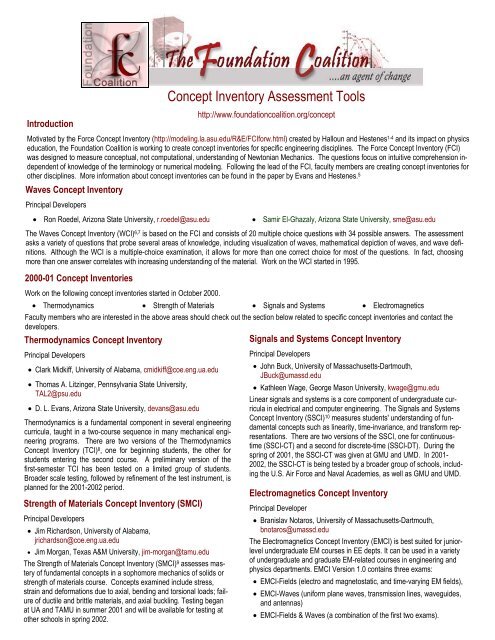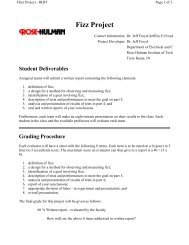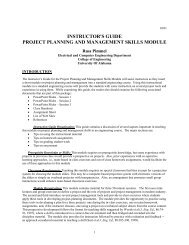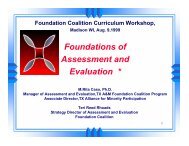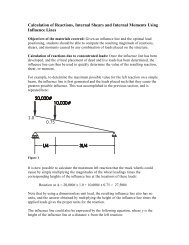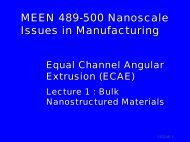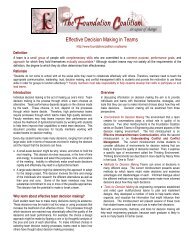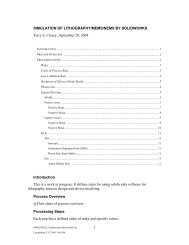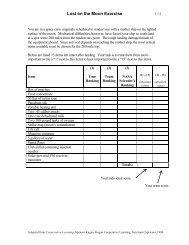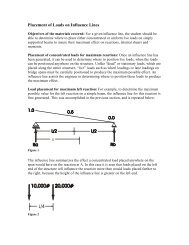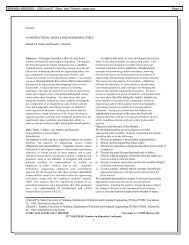Concept Inventory Assessment Tools - Foundation Coalition
Concept Inventory Assessment Tools - Foundation Coalition
Concept Inventory Assessment Tools - Foundation Coalition
- No tags were found...
You also want an ePaper? Increase the reach of your titles
YUMPU automatically turns print PDFs into web optimized ePapers that Google loves.
IntroductionWaves <strong>Concept</strong> <strong>Inventory</strong>Principal Developers Ron Roedel, Arizona State University, r.roedel@asu.edu<strong>Concept</strong> <strong>Inventory</strong> <strong>Assessment</strong> <strong>Tools</strong>http://www.foundationcoalition.org/conceptMotivated by the Force <strong>Concept</strong> <strong>Inventory</strong> (http://modeling.la.asu.edu/R&E/FCIforw.html) created by Halloun and Hestenes 1-4 and its impact on physicseducation, the <strong>Foundation</strong> <strong>Coalition</strong> is working to create concept inventories for specific engineering disciplines. The Force <strong>Concept</strong> <strong>Inventory</strong> (FCI)was designed to measure conceptual, not computational, understanding of Newtonian Mechanics. The questions focus on intuitive comprehension independentof knowledge of the terminology or numerical modeling. Following the lead of the FCI, faculty members are creating concept inventories forother disciplines. More information about concept inventories can be found in the paper by Evans and Hestenes. 5 Samir El-Ghazaly, Arizona State University, sme@asu.eduThe Waves <strong>Concept</strong> <strong>Inventory</strong> (WCI) 6,7 is based on the FCI and consists of 20 multiple choice questions with 34 possible answers. The assessmentasks a variety of questions that probe several areas of knowledge, including visualization of waves, mathematical depiction of waves, and wave definitions.Although the WCI is a multiple-choice examination, it allows for more than one correct choice for most of the questions. In fact, choosingmore than one answer correlates with increasing understanding of the material. Work on the WCI started in 1995.2000-01 <strong>Concept</strong> InventoriesWork on the following concept inventories started in October 2000. Thermodynamics Strength of Materials Signals and Systems ElectromagneticsFaculty members who are interested in the above areas should check out the section below related to specific concept inventories and contact thedevelopers.Thermodynamics <strong>Concept</strong> <strong>Inventory</strong>Principal Developers Clark Midkiff, University of Alabama, cmidkiff@coe.eng.ua.edu Thomas A. Litzinger, Pennsylvania State University,TAL2@psu.edu D. L. Evans, Arizona State University, devans@asu.eduThermodynamics is a fundamental component in several engineeringcurricula, taught in a two-course sequence in many mechanical engineeringprograms. There are two versions of the Thermodynamics<strong>Concept</strong> <strong>Inventory</strong> (TCI) 8 , one for beginning students, the other forstudents entering the second course. A preliminary version of thefirst-semester TCI has been tested on a limited group of students.Broader scale testing, followed by refinement of the test instrument, isplanned for the 2001-2002 period.Strength of Materials <strong>Concept</strong> <strong>Inventory</strong> (SMCI)Principal Developers Jim Richardson, University of Alabama,jrichardson@coe.eng.ua.edu Jim Morgan, Texas A&M University, jim-morgan@tamu.eduThe Strength of Materials <strong>Concept</strong> <strong>Inventory</strong> (SMCI) 9 assesses masteryof fundamental concepts in a sophomore mechanics of solids orstrength of materials course. <strong>Concept</strong>s examined include stress,strain and deformations due to axial, bending and torsional loads; failureof ductile and brittle materials, and axial buckling. Testing beganat UA and TAMU in summer 2001 and will be available for testing atother schools in spring 2002.Signals and Systems <strong>Concept</strong> <strong>Inventory</strong>Principal Developers John Buck, University of Massachusetts-Dartmouth,JBuck@umassd.edu Kathleen Wage, George Mason University, kwage@gmu.eduLinear signals and systems is a core component of undergraduate curriculain electrical and computer engineering. The Signals and Systems<strong>Concept</strong> <strong>Inventory</strong> (SSCI) 10 measures students' understanding of fundamentalconcepts such as linearity, time-invariance, and transform representations.There are two versions of the SSCI, one for continuoustime(SSCI-CT) and a second for discrete-time (SSCI-DT). During thespring of 2001, the SSCI-CT was given at GMU and UMD. In 2001-2002, the SSCI-CT is being tested by a broader group of schools, includingthe U.S. Air Force and Naval Academies, as well as GMU and UMD.Electromagnetics <strong>Concept</strong> <strong>Inventory</strong>Principal Developer Branislav Notaros, University of Massachusetts-Dartmouth,bnotaros@umassd.eduThe Electromagnetics <strong>Concept</strong> <strong>Inventory</strong> (EMCI) is best suited for juniorlevelundergraduate EM courses in EE depts. It can be used in a varietyof undergraduate and graduate EM-related courses in engineering andphysics departments. EMCI Version 1.0 contains three exams: EMCI-Fields (electro and magnetostatic, and time-varying EM fields), EMCI-Waves (uniform plane waves, transmission lines, waveguides,and antennas) EMCI-Fields & Waves (a combination of the first two exams).
2001-02 <strong>Concept</strong> InventoriesWork on the following concept inventories started in October 2001.CircuitsFluid Mechanics MaterialsFaculty members interested in working with developers to developconcept inventories in the above areas should contact a developerlisted in one of the sections below.Circuits <strong>Concept</strong> <strong>Inventory</strong>Principal Developers Robert Helgeland, University of Massachusetts-Dartmouth,rhelgeland@umassd.edu David Rancour, University of Massachusetts-Dartmouth,drancour@umassd.eduCircuit Theory is usually the first course in the major for electricalengineering and computer engineering students. Part One of theCircuits <strong>Concept</strong> <strong>Inventory</strong> (CCI) will measure a student’s conceptualunderstanding of the basic properties of electricity, circuit componentsand linear time-invariant networks (DC and AC). Part Twowill address frequency domain concepts, coupled inductors, convolution,impulse response, and transform techniques.Fluid Mechanics <strong>Concept</strong> <strong>Inventory</strong>Principal DevelopersJohn Mitchell, University of Wisconsin, mitchell@engr.wisc.eduJay Martin, University of Wisconsin, martin@engr.wisc.eduTy Newell, University of Illinois at Urbana-Champaign,t-newell@uiuc.eduThe goal of the Fluids Mechanics <strong>Concept</strong> <strong>Inventory</strong> (FMCI) is toestablish a common base of fluids concepts and provide instrumentsthat could be used by faculty to evaluate the degree to whichstudents in a given program have mastered those concepts. Theinventory would be conducted in each of the fluids classes at thestart of the semester to assess the knowledge of entering studentsand at the end of the semester to assess whether students havemastered the necessary concepts. An outcome of conducting theinventory might be modifications to the curriculum and courses toensure that students obtain the necessary understanding of the basicconcepts.Materials <strong>Concept</strong> <strong>Inventory</strong>Principal Developers Richard Griffin, Texas A&M University, richard.griffin@usma.edu Steve Krause, Arizona State University, skrause@asu.eduAn instrument is being developed to measure misconceptions on materialsstructure, processing, and properties. It will be used to examine studentknowledge before and after teaching introductory materials engineeringcourses that are required by many engineering colleges. Considerable researchshows that prior misconceptions are strongly held even in the face ofgood instruction. A better understanding of "prior knowledge" can helpinstructors improve instruction in their classes.References for Further Information1. Hestenes, David, Malcolm Wells, and Gregg Swackhamer (1992). Force <strong>Concept</strong><strong>Inventory</strong>. The Physics Teacher, 30 (3), 141-1512. Hestenes, David, and Ibrahim Halloun (1995). Interpreting the Force <strong>Concept</strong> <strong>Inventory</strong>.The Physics Teacher, 33 (8)3. Halloun, Ibrahim and David Hestenes (1985). The initial knowledge state of collegephysics students. American Journal of Physics, 53(11), 1043-1055.4. Halloun, Ibrahim and David Hestenes (1985). Common sense concepts about motion.American Journal of Physics, 53(11), 1056-10655. D. L. Evans and David Hestenes, "The <strong>Concept</strong> of the <strong>Concept</strong> <strong>Inventory</strong> <strong>Assessment</strong>Instrument,” Proceedings, 2001 Frontiers in Education Conference,Reno, Nevada, 10-13 October 20016. R. J. Roedel, S. El-Ghazaly, Teri Reed Rhoads, and E. El-Sharawy, “The Wave<strong>Concept</strong>s <strong>Inventory</strong> – An <strong>Assessment</strong> Tool for Courses in Electromagnetic Engineering,“ Proceedings, 1998 Frontiers in Education Conference, November 1998,Tempe, AZ.7. Rhoads, Teri Reed, Ron J. Roedel, "The Wave <strong>Concept</strong> <strong>Inventory</strong> - A CognitiveInstrument Based on Bloom’s Taxonomy,” Proceedings, 1999 Frontiers in EducationConference, San Juan, Puerto Rico, 10-13 November 19998. Midkiff, K. Clark, Thomas A. Litzinger, and D. L. Evans, "Development of EngineeringThermodynamics <strong>Concept</strong> <strong>Inventory</strong> Instruments,” Proceedings, 2001Frontiers in Education Conference, Reno, Nevada, 10-13 October 2001One-page FIE2001 working paper: http://fie.engrng.pitt.edu/fie2001/papers/1356.pdfFIE 20001 presentation: http://foundationcoalition.org/thermo9. Richardson, Jim, and Jim Morgan, "Development of an Engineering Strength ofMaterial <strong>Concept</strong> <strong>Inventory</strong> <strong>Assessment</strong> Instrument," Proceedings, 2001 Frontiersin Education Conference, Reno, Nevada, 10-13 October 2001One-page FIE2001 working paper: http://fie.engrng.pitt.edu/fie2001/papers/1353.pdfFIE 20001 presentation: http://foundationcoalition.org/strength10. Wage, Kathleen E., and John R. Buck, “Development of the Signals and Systems<strong>Concept</strong> <strong>Inventory</strong> (SSCI) <strong>Assessment</strong> Instrument,” Proceedings, 2001 Frontiersin Education Conference, Reno, Nevada, 10-13 October 2001One-page FIE2001 working paper: http://fie.engrng.pitt.edu/fie2001/papers/1358.pdfFIE 20001 presentation: http://foundationcoalition.org/systemWhether you're just getting started or looking for some additional ideas, the <strong>Foundation</strong> <strong>Coalition</strong> would like to help you incorporate concept inventory assessmentinstruments into your engineering classes through workshops, web sites, lesson plans, and reading materials. For suggestions on where to start,see our web site at http://www.foundationcoalition.org or contact: Jeffrey Froyd at froyd@ee.tamu.edu or 979-845-7574.


